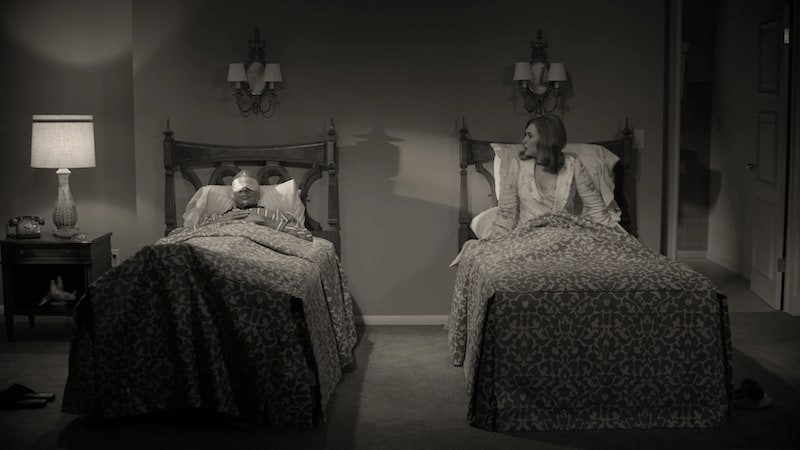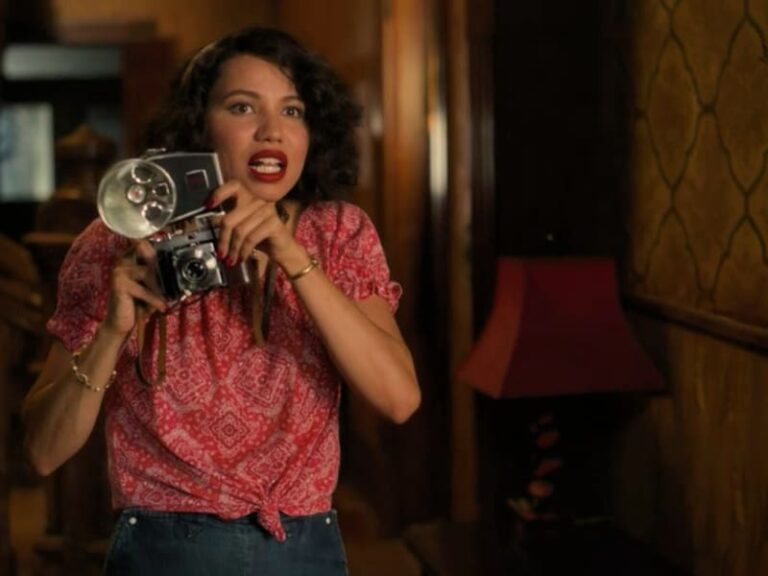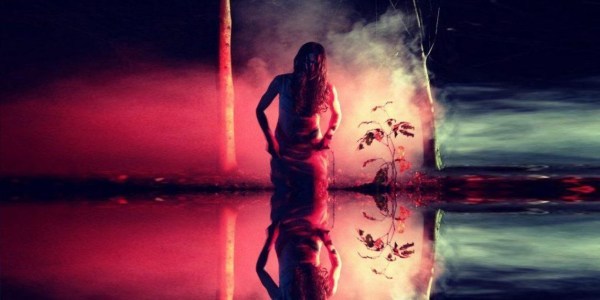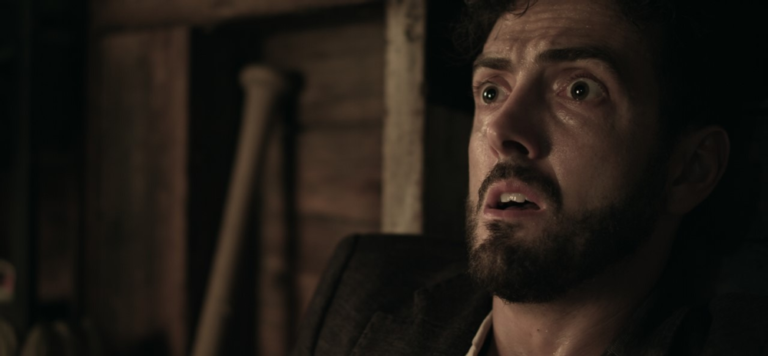The Perfect Pastiche of TV Tropes and Trends in ‘WandaVision’
Who’s the big bad of WandaVision? Where is the series taking us in the grand scheme of the Marvel Cinematic Universe? What plot twists will be revealed next week? These are all valid questions for viewers of the Disney+ show, particularly those who are primarily interested and invested in the program as content to be consumed. For some of us, though, the comic book connectivity isn’t as satisfying as the way the show simultaneously presents a pastiche of television history. WandaVision isn’t just casually using beloved sitcoms as a fun backdrop for the story of a grieving superhero who is manipulating reality. The makers of this series (including director Matt Shakman, a former child actor who co-starred on the 1980s sitcom Just the Ten of Us and appeared on such shows as Diff’rent Strokes, Webster, and The Facts of Life!) genuinely love and understand the tropes and trends of popular television over the course of sixty-plus years.
The brilliance of WandaVision is that its pastiche is so broad yet also so refined. The Coen brothers may be the kings of the collective celebration of a time and a place (a la postwar America in The Man Who Wasn’t There or the early Depression-era of O Brother, Where Art Thou?), and Noah Hawley may, in turn, be a master of comprehending the Coens’ genius and churning it out as its own pastiche with the series Fargo (he also gave us the most interesting pre-WandaVision Marvel-based TV show: Legion). But week-to-week, WandaVision changes up its focus while on a steady path through the decades. What might look like a random selection of production design motifs and jokes paying homage to certain TV shows of the ’60s, ’70s, ’80s, and 2000s is so well thought out that some of the show’s most clever aspects may have even come about subconsciously.
While there are plenty of superhero and comic book movies that transcend the surface material to become accessible to fans of other genres and areas of interest, few if any are so layered in their levels of appeal and appreciation as WandaVision. This isn’t a sitcom mashup that happens to be a superhero show or a superhero show that happens to be a sitcom mashup. It’s an equal balance of the two. And while those angles and others provide a gateway for a variety of audiences to approach and enjoy WandaVision for different reasons (making for one of the most talked-about shows in years), it wouldn’t work as well without the other parts — especially either the MCU context or the precise TV references.
Ahead of the climactic final installments of the show, I’d like to take a look at the first seven episodes of WandaVision and highlight the ways each segment, as well as the big picture, is cleverly navigating through the history of the sitcom and its significance to the television medium as it reveals as much about TV tropes, trends, and transitions in television’s evolution as it does the main Marvel characters and where it’s situated and taking us within the grander mega-franchise.
Episode 1: “Filmed Before a Live Studio Audience”
Although WandaVision is not the first TV series connected to the MCU, it is the first television program produced by Marvel Studios, so it’s the perfect opportunity to pay tribute to the medium in a metatextual manner. From the start, the show seems to capitalize on the nostalgia of not just the original eras of its sitcom worship but also to their resurrection via Nick at Nite and TV Land and other outlets, through which much of the current Marvel creatives and its fanbase would have seen these oldies but goodies. There’s obviously a retrospective point of view to this pastiche compared to the way Captain America: The First Avenger and Captain Marvel situate us within their respective past time-period settings, even as they’re being similarly imitative in their evocation.
Like the earliest American sitcoms — most notably in the first episode, there are direct nods to The Donna Reed Show (1958-1966) and The Dick Van Dyke Show (1961-1966) — the inaugural episode of WandaVision offers an odd mix of confined yet exposed space, in which a set of characters live in a bubble but with outlets for both live and broadcast scrutiny. The sitcom is an escape from the real world but constantly reminds us of its artifice through the laughter and other reactions of the live studio audience as well as the stationary lens of the camera and its positioned alignment with the studio audience as if watching a theatrical production on a stage where the scope of action is bordered by and only acknowledges three walls of any setpiece.
Especially to an outsider who grew up in a state of wartorn poverty, among other traumas, as Wanda Maximoff (Elizabeth Olsen) may have been watching old reruns on local Sokovian television, the US-produced sitcom might present a fantasy of the American dream, of a perfect middle-class nuclear family in the suburbs with only as much drama as would allow for humorous situations. You’ve got plots dealing with attempts to conceal anything abnormal or embarrassing, such as the case of a boss coming to dinner and the accidents, mishaps, blunders, and miscommunications that might tarnish the sheen of perfection and jeopardize the ability to have this ideal lifestyle. And that also goes for the shows themselves, hiding (away/from) most real-world issues and problems.
Because the first episode of WandaVision has Wanda and Vision (Paul Bettany) as a childless couple, it’s not an exact representation of the family sitcom. Instead, there’s also a bit of I Love Lucy (1951-1957) with a focus on the housewife getting into trouble through little imperfections and lies. But where the wife is meant to be more of this impossible woman who can whip up a huge breakfast and do all the chores and run a family’s lives, the gag is that WandaVision‘s central figure is literally a magical woman, (which of course, leads to the next era and next episode for the show). And Vision is a construct of an infallible super-man, with powers of his own that allow him to fit in and that render him incapable of even falling over furniture, as the still-only-human Dick Van Dyke would (Van Dyke, who is now in his nineties, consulted on the show, by the way!).
But the fake perfect ideals of early sitcoms wouldn’t last forever, and so as immaculate as their attempt at denial of the real world is (and for Wanda’s grief, the denial is rooted in a tragedy that must be confronted), that facade can’t hold. The question, though, is why Wanda would create this perfect fantasy situation and have it be broadcast in a way that outsiders can tune in. A false front, pretending that everything is okay as a request to leave them alone? A cry for help? And if it wasn’t Wanda all along who’d created the enclosed alternate world of Westview, the question remains. Is it just the fact of the matter that, as we see in later eras and episodes, a sitcom reality can not be disconnected from a certain sense of playful awareness of self and audience?

Episode 2: “Don’t Touch That Dial”
After the sitcom setup of “Filmed Before a Live Studio Audience,” the main points of pastiche are established for WandaVision and the show continues to build upon the themes and tropes that have followed the TV genre through the years. But “Don’t Touch That Dial” has fun with some of the sitcom’s evolution, in terms of narrative trends and format changes. After all, you can’t have a show starring a woman with magical powers that pays tribute to sitcoms and not include specific homages to such fantastical TV classics as Bewitched (1964-1972), about a witch who marries a mortal man and settles into suburbia, and I Dream of Jeannie (1965-1970), which has a similar plot except the magical housewife is a genie from a bottle.
The former gets direct and blatant recognition through the second episode’s animated opening credits and similar theme song, but there are a few other noteworthy ways in which that particular series fit into WandaVision‘s pastiche of television history. One is the nosey neighbor. Another big one is that the magic show plot of the episode, with its incapable magician and actual-magical assistance, is lifted right from a Season 1 Bewitched episode (“It’s Magic”). Then there’s the gag in which Wanda and Vision sleep in separate single beds but then magically pull them together. Due to the moral code for film and TV production, even married couples couldn’t be seen sleeping in the same bed — until the 1960s. Bewitched was one of the first major shows to break the norm and eventually featured one bed for the couple. Bewitched was also a show that aired long enough to transition from black and white to color, which is another reason it’s a perfect model for the episode of WandaVision in which the visuals of the show within the show changes from black and white to color.

The post The Perfect Pastiche of TV Tropes and Trends in ‘WandaVision’ appeared first on Film School Rejects.





